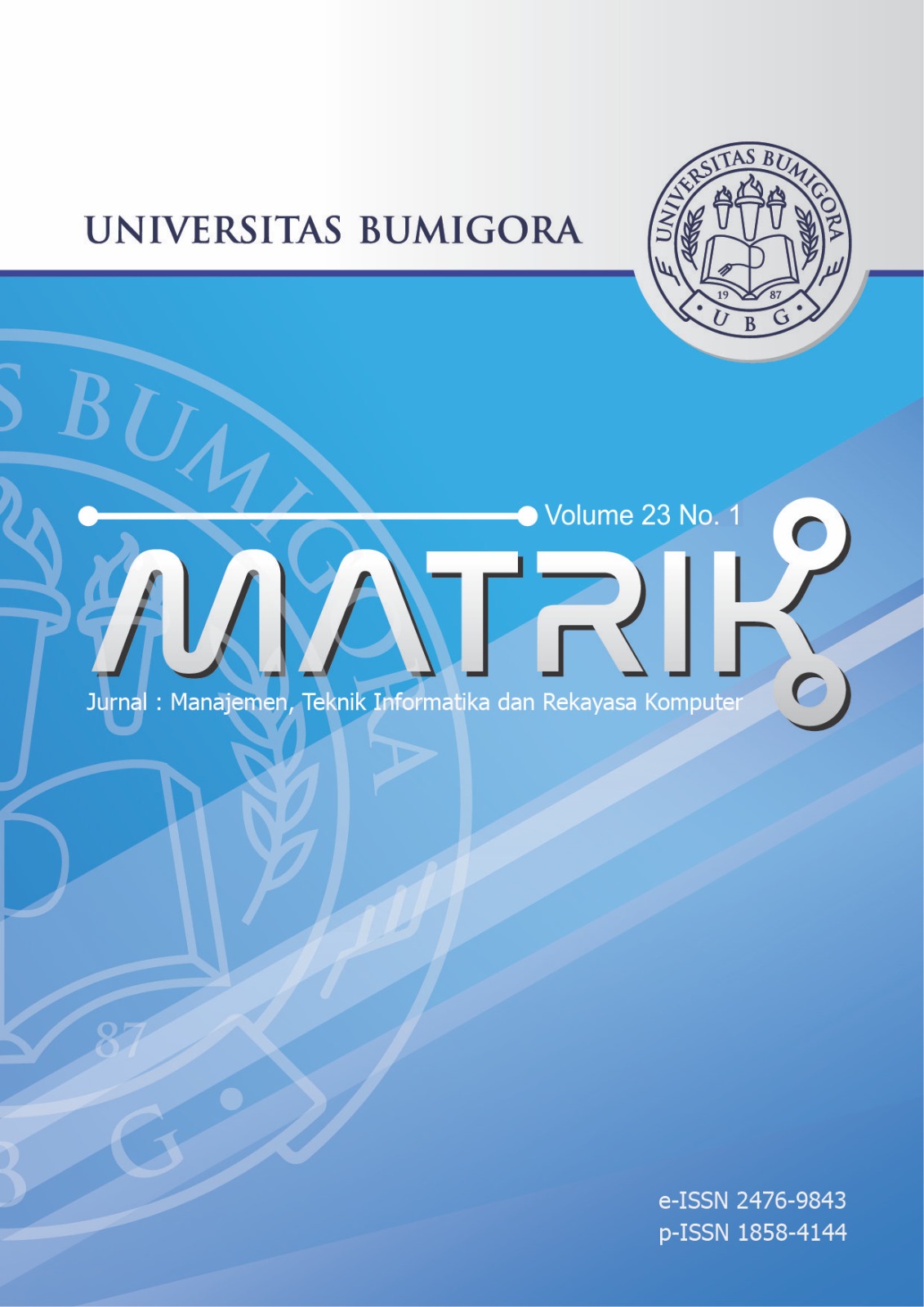Analyzing Sentiment with Self-Organizing Map and Long Short-Term Memory Algorithms
DOI:
https://doi.org/10.30812/matrik.v23i1.3332Keywords:
Long Short-Term Memory, Memory Algoritms, Self-Organizing Map, Sentiment AnalysisAbstract
This research delves into the impact of Chat Generative Pre-trained Transformer, one of Open Artificial Intelligence Generative Pretrained Transformer models. This model underwent extensive training on a vast corpus of internet text to gain insights into the mechanics of human language and its role in forming phrases, sentences, and paragraphs. The urgency of this inquiry arises from Chat Generative Pre-trained Transformer emergence, which has stirred significant debate and captured widespread attention in both research and educational circles. Since its debut in November 2022, Chat Generative Pre-trained Transformer has demonstrated substantial potential across numerous domains. However, concerns voiced on Twitter have centered on potential negative consequences, such as increased
forgery and misinformation. Consequently, understanding public sentiment toward Chat Generative Pre-trained Transformer technology through sentiment analysis has become crucial. The research’s primary objective is to conduct Sentiment Analysis Classification of Chat Generative Pre-trained Transformer regarding public opinions on Twitter in Indonesia. This goal involves quantifying and categorizing public sentiment from Twitter’s vast data pool into three clusters: positive, negative, or neutral. In the data clustering stage, the Self-Organizing Map technique is used. After the text data has been weighted and clustered, the next step involves using the classification technique with Long
Short-Term Memory to determine the public sentiment outcomes resulting from the presence of Chat Generative Pre-trained Transformer technology. Rigorous testing has demonstrated the robust performance of the model, with optimal parameters: relu activation function, som size of 5, num epoch som and num epoch lstm both at 128, yielding an impressive 95.07% accuracy rate.
Downloads
References
Artificial Intelligence-written research papers and the ethics of the large language models in scholarly publishing,â€
Journal of the Association for Information Science and Technology, vol. 74, no. 5, pp. 570–581, may 2023.
[Online]. Available: https://onlinelibrary.wiley.com/doi/full/10.1002/asi.24750https://onlinelibrary.wiley.com/doi/abs/10.1002/
asi.24750https://asistdl.onlinelibrary.wiley.com/doi/10.1002/asi.24750
[2] N. Shi, Q. Zeng, and R. Lee, “Language Chatbot-The Design and Implementation of English Language Transfer Learning Agent
Apps,†2020 IEEE 3rd International Conference on Automation, Electronics and Electrical Engineering, AUTEEE 2020, pp.
403–407, nov 2020.
[3] J. Kleesiek, Y. Wu, G. Stiglic, J. Egger, and J. Bian, “An Opinion on ChatGPT in Health CareWritten by Humans Only,â€
Journal of Nuclear Medicine, vol. 64, no. 5, pp. 701–703, apr 2023. [Online]. Available: https://jnm.snmjournals.org/content/
early/2023/04/13/jnumed.123.265687https://jnm.snmjournals.org/content/early/2023/04/13/jnumed.123.265687.abstract
[4] A. Faesal, A. Muslim, A. H. Ruger, and K. Kusrini, “Sentimen Analisis pada Data Tweet Pengguna Twitter
Terhadap Produk Penjualan Toko Online Menggunakan Metode K-Means,†MATRIK : Jurnal Manajemen, Teknik
Informatika dan Rekayasa Komputer, vol. 19, no. 2, pp. 207–213, may 2020. [Online]. Available: https:
//journal.universitasbumigora.ac.id/index.php/matrik/article/view/640
[5] I. Dergaa, K. Chamari, P. Zmijewski, and H. B. Saad, “From human writing to artificial intelligence generated text: examining
the prospects and potential threats of ChatGPT in academic writing,†Biology of Sport, vol. 40, no. 2, pp. 615–622, 2023.
[Online]. Available: https://doi.org/10.5114/biolsport.2023.125623
[6] Y. Akbar and T. Sugiharto, “Analisis Sentimen Pengguna Twitter di Indonesia Terhadap ChatGPT Menggunakan Algoritma
C4.5 dan Na¨ıve Bayes (Yuma Akbar 1*, Tri Sugiharto 2 ) Analisis Sentimen Pengguna Twitter di Indonesia Terhadap ChatGPT
Menggunakan Algoritma C4.5 dan Na¨ıve Bayes,†Jurnal Sains dan Teknologi, vol. 5, no. 1, pp. 115–122, 2023. [Online].
Available: https://doi.org/10.55338/saintek.v4i3.1368
[7] M. Farrokhnia, S. K. Banihashem, O. Noroozi, and A. Wals, “A SWOT analysis of ChatGPT: Implications for
educational practice and research,†Innovations in Education and Teaching International, apr 2023. [Online]. Available:
https://www.tandfonline.com/doi/abs/10.1080/14703297.2023.2195846
[8] N. N. Amir Sjarif, N. F. Mohd Azmi, S. Chuprat, H. M. Sarkan, Y. Yahya, and S. M. Sam, “SMS Spam Message Detection
using Term Frequency-Inverse Document Frequency and Random Forest Algorithm,†Procedia Computer Science, vol. 161, pp.
509–515, jan 2019.
[9] A. Patil, “Word Significance Analysis in Documents for Information Retrieval by LSA and TF-IDF using Kubeflow,†Lecture
Notes in Networks and Systems, vol. 209, pp. 335–348, 2022. [Online]. Available: https://link.springer.com/chapter/10.1007/
978-981-16-2126-0f g29
[10] F. Mikael Sinaga, P. Sirait, and A. Halim, “Optimization of SV-kNNC using Silhouette Coefficient and LMKNN for Stock Price
Prediction,†2020 3rd International Seminar on Research of Information Technology and Intelligent Systems, ISRITI 2020, pp.
326–331, dec 2020.
[11] D. I. Af’idah, D. Dairoh, S. F. Handayani, R. W. Pratiwi, and S. I. Sari, “Sentimen Ulasan Destinasi Wisata Pulau Bali
Menggunakan Bidirectional Long Short Term Memory,†MATRIK : Jurnal Manajemen, Teknik Informatika dan Rekayasa
Komputer, vol. 21, no. 3, pp. 607–618, jul 2022. [Online]. Available: https://journal.universitasbumigora.ac.id/index.php/
matrik/article/view/1402
[12] F. D. Ananda and Y. Pristyanto, “Analisis Sentimen Pengguna Twitter Terhadap Layanan Internet Provider Menggunakan
Algoritma Support Vector Machine,†MATRIK : Jurnal Manajemen, Teknik Informatika dan Rekayasa Komputer, vol. 20, no. 2,
pp. 407–416, may 2021. [Online]. Available: https://journal.universitasbumigora.ac.id/index.php/matrik/article/view/1130
[13] P. T. Putra, A. Anggrawan, and H. Hairani, “Comparison of Machine Learning Methods for Classifying User Satisfaction
Opinions of the PeduliLindungi Application,†MATRIK : Jurnal Manajemen, Teknik Informatika dan Rekayasa Komputer,
vol. 22, no. 3, pp. 431–442, jun 2023. [Online]. Available: https://journal.universitasbumigora.ac.id/index.php/matrik/article/
view/2860
[14] W. Riyadi and J. Jasmir, “Performance Prediction of Airport Traffic Using LSTM and CNN-LSTM Models,†MATRIK :
Jurnal Manajemen, Teknik Informatika dan Rekayasa Komputer, vol. 22, no. 3, pp. 627–638, jul 2023. [Online]. Available:
https://journal.universitasbumigora.ac.id/index.php/matrik/article/view/3032
[15] V. Raveendirarasa and C. R. Amalraj, “Sentiment Analysis of Tamil-English Code-Switched Text on Social Media Using Sub-
Word Level LSTM,†Proceedings of ICITR 2020 - 5th International Conference on Information Technology Research: Towards
the New Digital Enlightenment, dec 2020.
[16] M. K. Anam, B. N. Pikir, M. B. Firdaus, S. Erlinda, and A. Agustin, “Penerapan Na¨ıve Bayes Classifier, K-Nearest Neighbor
(KNN) dan Decision Tree untuk Menganalisis Sentimen pada Interaksi Netizen dan Pemeritah,†MATRIK : Jurnal Manajemen,
Teknik Informatika dan Rekayasa Komputer, vol. 21, no. 1, pp. 139–150, nov 2021.
[17] A. J. Makrufi, W. Fawwaz, and A. Maki, “Support vector machine with a firefly optimization algorithm for classification of
apple fruit disease,†MATRIK : Jurnal Manajemen, Teknik Informatika dan Rekayasa Komputer, vol. 22, no. 1, pp. 177–188,
nov 2022. [Online]. Available: https://journal.universitasbumigora.ac.id/index.php/matrik/article/view/2365
Analyzing
Downloads
Published
Issue
Section
How to Cite
Similar Articles
- Romi Choirudin, Ahmat Adil, Implementasi Rest Api Web Service dalam Membangun Aplikasi Multiplatform untuk Usaha Jasa , MATRIK : Jurnal Manajemen, Teknik Informatika dan Rekayasa Komputer: Vol. 18 No. 2 (2019)
- Jusmita Weriza, Ismail Husein, Noranizamardia Noranizamardia, M Fakhariza, Khairan Marzuki, Development of OnlineWeb-Based New Student Graduation Application in Junior High School , MATRIK : Jurnal Manajemen, Teknik Informatika dan Rekayasa Komputer: Vol. 21 No. 3 (2022)
- Umar Aditiawarman, Alfian Dody, Teddy Mantoro, Haris Al Qodri Maarif, Anggy Pradiftha, Evading Antivirus Software Detection Using Python and PowerShell Obfuscation Framework , MATRIK : Jurnal Manajemen, Teknik Informatika dan Rekayasa Komputer: Vol. 22 No. 3 (2023)
- Reni Fatrisna Salsabila, Didik Dwi Prasetya, Triyanna Widyaningtyas, Tsukasa Hirashima, Comparison of Text Representation for Clustering Student Concept Maps , MATRIK : Jurnal Manajemen, Teknik Informatika dan Rekayasa Komputer: Vol. 24 No. 2 (2025)
- Ni Wayan Sumartini Saraswati, I Gusti Ayu Agung Diatri Indradewi, Recognize The Polarity of Hotel Reviews using Support Vector Machine , MATRIK : Jurnal Manajemen, Teknik Informatika dan Rekayasa Komputer: Vol. 22 No. 1 (2022)
- Jelita Asian, Dimas Erlangga, Media Ayu, Data Exfiltration Anomaly Detection on Enterprise Networks using Deep Packet Inspection , MATRIK : Jurnal Manajemen, Teknik Informatika dan Rekayasa Komputer: Vol. 22 No. 3 (2023)
- Ardi Mardiana, Ade Bastian, Ano Tarsono, Dony Susandi, Safari Yonasi, Optimized YOLOv8 Model for Accurate Detection and Quantificationof Mango Flowers , MATRIK : Jurnal Manajemen, Teknik Informatika dan Rekayasa Komputer: Vol. 24 No. 3 (2025)
- Halim Budi Santoso, Darma Cahyadi, Erick Kurniawan, PROGAM BANTU PEMESANAN JASA PERBAIKAN AC STUDI KASUS: CV. KURNIATAMA , MATRIK : Jurnal Manajemen, Teknik Informatika dan Rekayasa Komputer: Vol. 16 No. 2 (2017)
- Fiby Nur Afiana, Pungkas Subarkah, A. Kholil Hidayat, Analisis Perbandingan Metode TAM dan Metode UTAUT 2 dalam Mengukur Kesuksesan Penerapan SIMRS pada Rumah Sakit Wijaya Kusuma DKT Purwokerto , MATRIK : Jurnal Manajemen, Teknik Informatika dan Rekayasa Komputer: Vol. 19 No. 1 (2019)
- Lusiana Efrizoni, Sarjon Defit, Muhammad Tajuddin, Anthony Anggrawan, Komparasi Ekstraksi Fitur dalam Klasifikasi Teks Multilabel Menggunakan Algoritma Machine Learning , MATRIK : Jurnal Manajemen, Teknik Informatika dan Rekayasa Komputer: Vol. 21 No. 3 (2022)
You may also start an advanced similarity search for this article.


.png)












